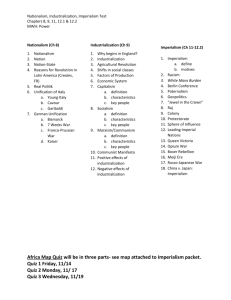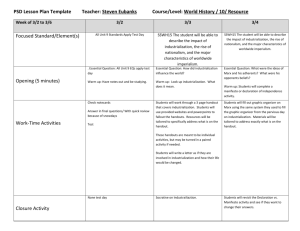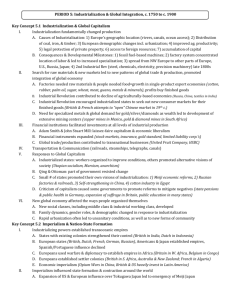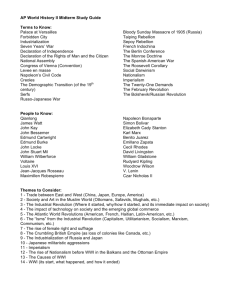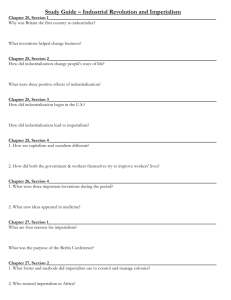Industrial Revolution: England, Germany, Japan Worksheet
advertisement
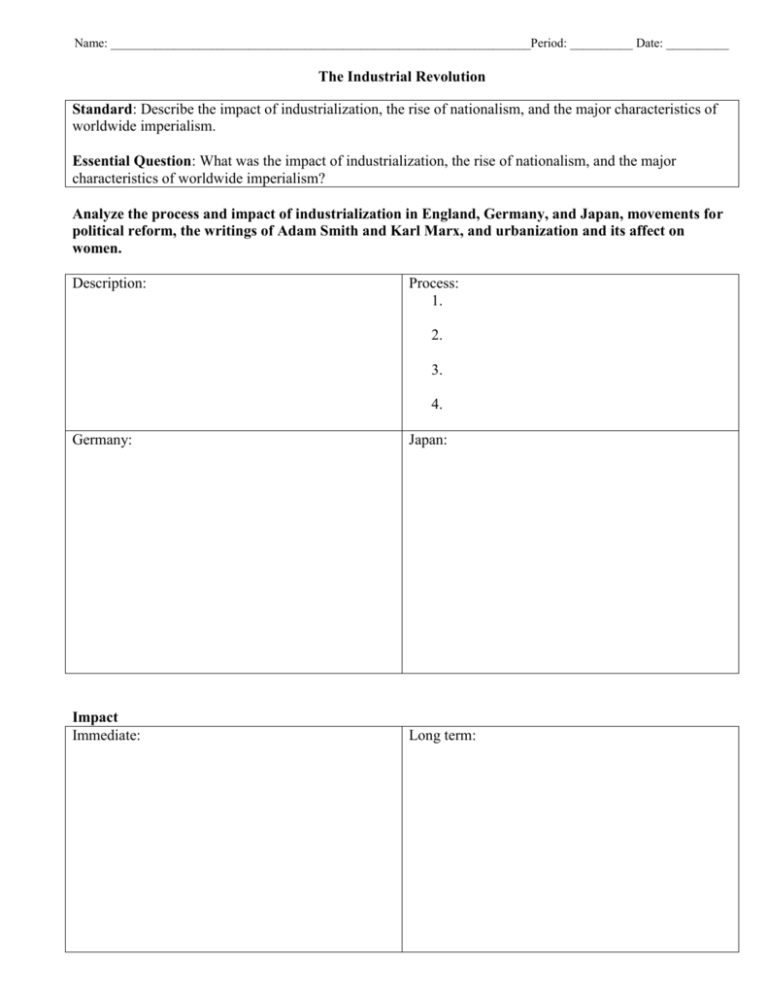
Name: ___________________________________________________________________Period: __________ Date: __________ The Industrial Revolution Standard: Describe the impact of industrialization, the rise of nationalism, and the major characteristics of worldwide imperialism. Essential Question: What was the impact of industrialization, the rise of nationalism, and the major characteristics of worldwide imperialism? Analyze the process and impact of industrialization in England, Germany, and Japan, movements for political reform, the writings of Adam Smith and Karl Marx, and urbanization and its affect on women. Description: Process: 1. 2. 3. 4. Germany: Japan: Impact Immediate: Long term: Essential Question: What was the impact of industrialization, the rise of nationalism, and the major characteristics of worldwide imperialism? Political Reforms The Factory Act of 1833: The Mines Act of 1842: The Ten Hours Act of 1847: Economic Impact Capitalism Communism Author Book Belief of Ownership Belief of Progress Role of Government Basic Beliefs Urbanization Description: Women: The Industrial Revolution Standard: Describe the impact of industrialization, the rise of nationalism, and the major characteristics of worldwide imperialism. Essential Question: What was the impact of industrialization, the rise of nationalism, and the major characteristics of worldwide imperialism? Analyze the process and impact of industrialization in England, Germany, and Japan, movements for political reform, the writings of Adam Smith and Karl Marx, and urbanization and its affect on women. Description: 1760-1840 the process of developing machine produced goods begins in England but eventually spreads to Europe into Germany and Asia to Japan(Commodore Perry) change of source of power from wood burning to the use of water and coal 1870-1914 Second Industrial Revolution introduction of steel to replace iron electricity replaced waterpower advanced system of transportation and communication Process: 5. Large population 6. Extensive natural resources (i.e. water power, coal, and iron ore) 7. Expanding economy (people able to invest in business for a profit) 8. Political stability (no major wars fought in Britain) Growth in Germany Germany had obstacles in their Industrial growth. Early in the 1800’s Germany was not a unified nation, so there was no political stability. Another problem that occurred would be the geographic issues of scattered resources. With the development of the railroad system those isolated industrialized cities were able to connect with one another. In west central Germany known as the Ruhr Valley, was rich in coal and iron ore. With the railroad these raw materials were able to be connected to the industrialized cities. Germany began in 1835 to import British equipment and workers. Germany also sent their youth to school in England to learn about industrial management. By the end of the 1800’s the industrialization allowed for Germany to gain in economic strength to develop a powerful military. Industrialization in Japan With the beginning of the Meiji era in Japan in 1868, the central government began an ambitious program to transform the country into an industrialized state. It financed textile mills, coal mines, shipyards, and cement and other factories. It also asked private companies to invest in industry. Some companies had been in business since the 1600’s. But new companies sprang up too. Among them was the Mitsubishi Company, founded in 1870 and still is in business today. The industrializing of Japan produced sustained economic growth for the country. But it also led to strengthening of the military and to Japanese imperialism in Asia. Impact New inventions (steam engine, steam boat, more modern roads, rail roads) Period of producing goods with machines in factories from hand-crafted at home Growth of factories Highly developed banking and investment system Increased production of goods Growth of middle class (industrial leaders, industrial workers) Worldwide trade Increased demand for raw materials Expand imperialism Increased competition between industrialized nations militarism Essential Question: What was the impact of industrialization, the rise of nationalism, and the major characteristics of worldwide imperialism? Political Reforms The Factory Act of 1833: Illegal to hire children under 9 years old 9 to 12 could not work more than 8 hours a day 13 to 17 could not work more than 12 hours The Mines Act of 1842: Prevented women and children from working underground The Ten Hours Act of 1847: Limited the work day to ten hours for women and children who worked in factories Adam Smith and Karl Marx Capitalism v. Socialism Adam Smith The Wealth of Nations Individuals and business own property and the means of production Progress results when individuals follow their own self-interest Author Book Belief on Ownership Belief of Progress Government should not interfere in the economy because competition creates efficiency in business Role of Government Businesses follow their own selfinterest by competing for the consumer’s money. Each business tries to produce goods or services that are better less expensive than those of competitors Consumers compete to buy the best goods at the lowest prices. This competition shapes the market by affecting what business are able to sell Basic Beleifs Urbanization Description: The use of machines to manufacture goods changed where people worked: in factories rather than at home. It also changed where they lived: in cities Karl Marx The Communist Manifesto The community or the state should own property and the means of production Progress results when a community of producers cooperate for the food of all An unequal distribution of wealth and material goods is unfair. A better system is to distribute goods according to each person’s need Socialists believe that capitalist employers take advantage of workers. The community or state must act to protect workers Capitalism creates unequal distribution of wealth and material goods. A better system is to distribute goods according to each person’s need. Women: Women were legally inferior to and economically dependent on men. Women took more and more of the textile industry jobs. They were unskilled and were rather than on farms. The demand for city life led to city building, along with the movement of people migrating from the farm or rural area to the cities or urban areas paid half or less than the men. Excessive working hours for women were outlawed in 1844. I. The employment of women and children was a holdover from the cottage industry system. The laws restricting industrial work for women and children led to a new pattern of work, therefore. Married men were now expected to support the family, and married women were to take care of the home and perform low-paying jobs in the home, such as taking in laundry, to help the family survive. Rise of women’s suffrage
